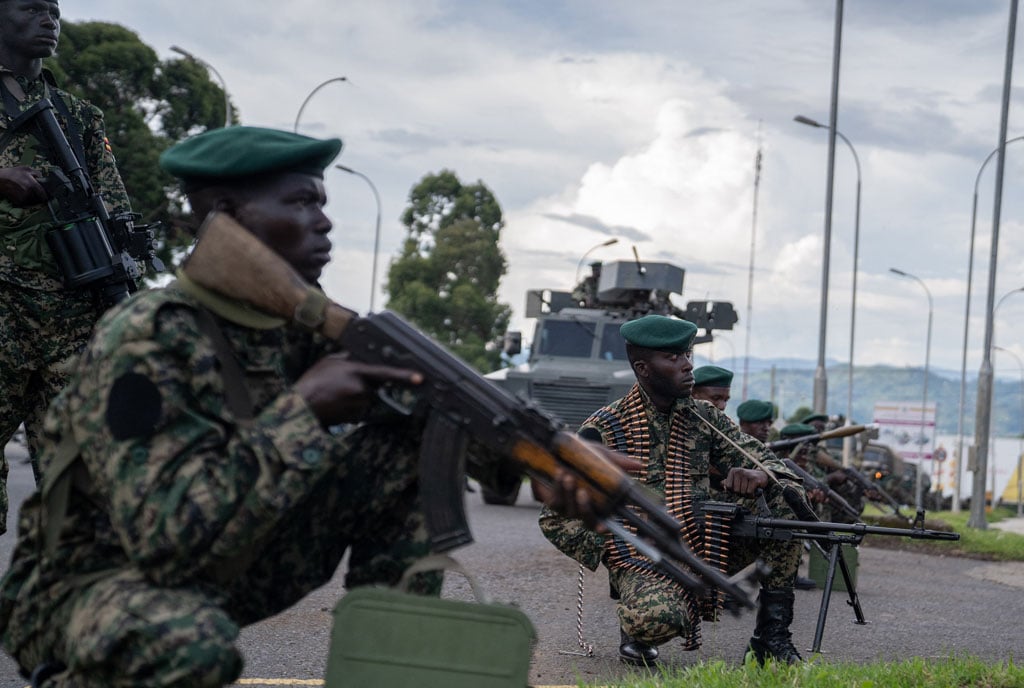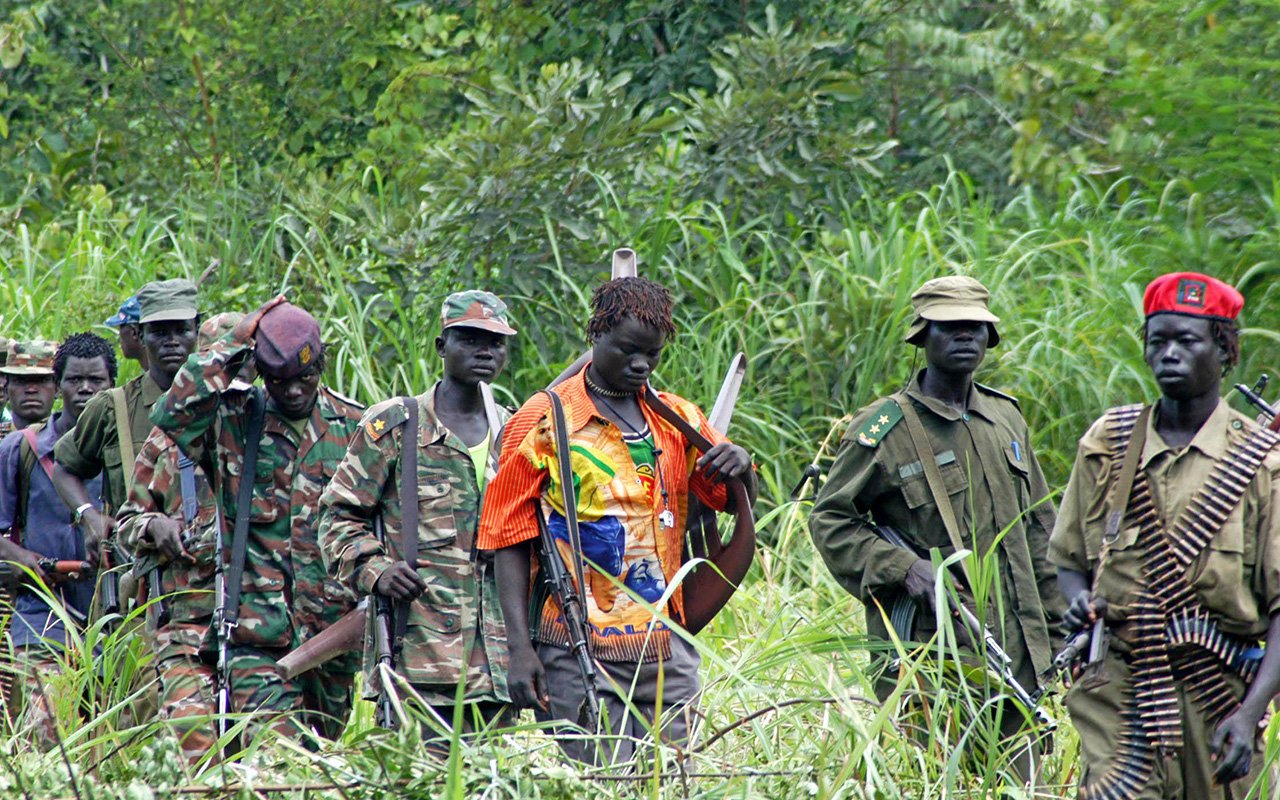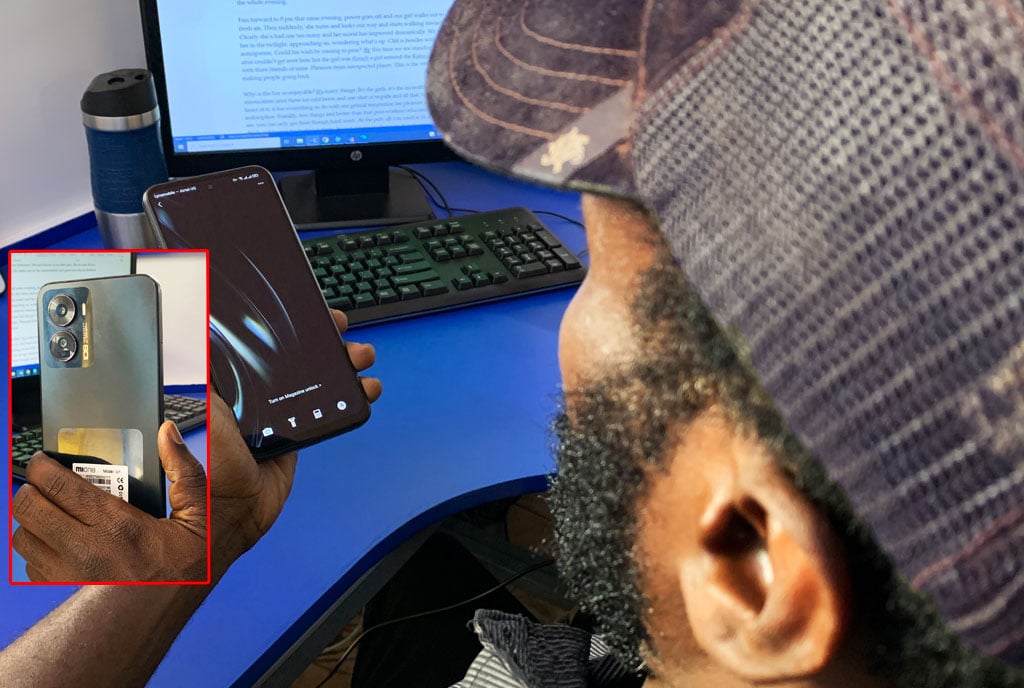Prime
What new UPDF structure means
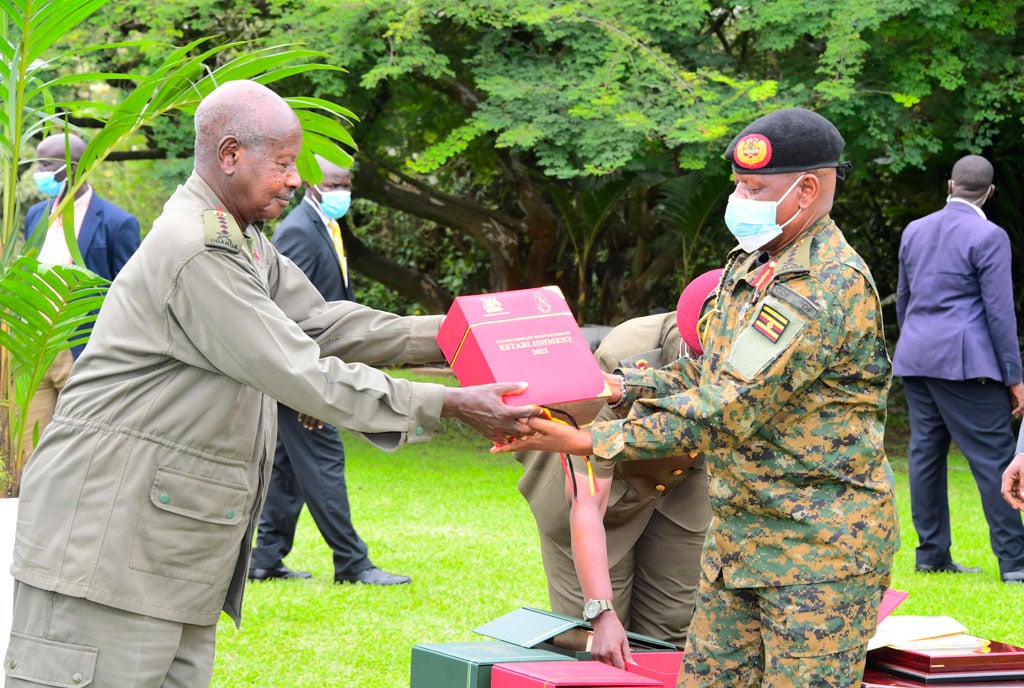
President Museveni, also the Commander-in-Chief of the Uganda People’s Defence Forces (left), receives a copy of the UPDF Establishment book from the Chief of Defence Forces, Gen Wilson Mbadi, during that Defence Forces Council meeting at State House Entebbe on February 17, 2024. PHOTO/HANDOUT
What you need to know:
- A landmark reform of the national defence architecture detailed in a new Establishment document, has been clouded by a presidential announcement on Sunday that appeared to re-appoint Chief of Defence Forces, Gen Wilson Mbadi, to the job he is holding.
The army has adopted a new organisational structure that re-hats command and control of all its elements under the Chief of Defence Forces (CDF) who in turn will superintend an expanded Joint Services Headquarters.
Gen Wilson Mbadi is the incumbent and his deputy, Lt Gen Peter Elwelu, will double as the inspector general of the army, meaning enforcing in the institution right way of doing right things.

Unlike before in the country’s military history, going forward a person will only be eligible for appointment as CDF, an equivalent of army commander, if at the rank of a four-star general.
There are currently a handful of active-duty full generals in UPDF, among them, Works minister Katumba Wamala, Internal Affairs State Minister David Muhoozi, and First Son and Senior Presidential Advisor on Special Operations Muhoozi Kainerugaba.
MUST READ: Evolution of army in Uganda
Any of them theoretically is qualified for the top military leadership position currently held by Gen Mbadi, although the President, as commander-in-chief, can at any time promote other officers to full-star generals to widen the net for his pick.
The reform in the army is the deepest since the transition of NRA to UPDF and comes seven months after UPDF retired nine influential generals and about 100 senior officers in July 2023, marking a power shift from the bush war historicals to young Turks in the military.
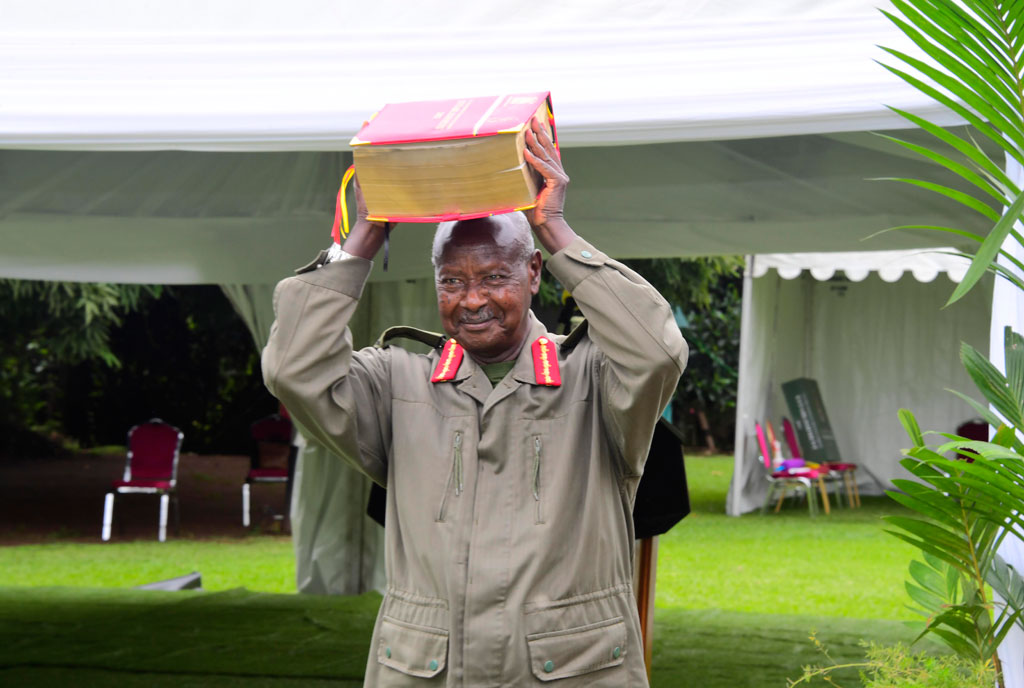
President Museveni carries the UPDF Establishment book at State House Entebbe on February 17, 2024. PHOTO/HANDOUT
Under the revised organogram detailed in the army’s revised Establishment, an organisational structure and doctrine document that the Defence Council approved on Saturday, the third highest office in the UPDF will be a Chief of Joint Staff (CJS), previously held by the Commander of Land Forces.
The CJS will supervise up to 14 Joint Staffs, which are upgraded chiefs of services, in addition to the army’s multi-billion-shilling Wazalendo Savings and Credit Cooperative Society (Sacco).
Highly-placed sources briefed on the changes said the Chieftaincy of Military Intelligence (CMI) has been renamed Chieftaincy of Defence Intelligence and Security and placed under supervision of the CJS who is expected to develop policies and strategies and chaperon transformation of the UPDF into a modern and professional army.
The Chief of Personnel and Administration is now a Joint Staff for Human Resource Management while the Defence/UPDF Spokesman, who is currently Brig Felix Kulayigye, becomes the Defence Public Information Officer (DPIO).
He will oversee a battery of division, battalion and other formation public information officers with responsibilities to project and keep a positive image of the UPDF.
Another source said the reorganisation of the military is to fulfill its longstanding professionalisation and modernisation agenda spearheaded by Gen Museveni and standardise hierarchy, ranks, mandates and required strength to make the force agile and interoperable within and outside Uganda.
Proponents say the provisions in the new document, officially cited as UPDF Establishment 2021, are to restructure functions and organisations of different elements in order to enhance their flexibility, coordination and performance across services.
The Establishment was put together by a committee appointed on July 30, 2015 and chaired by Lt Gen Pecos Kutesa who died in August 2021 when the army’s chief of doctrine synthesisation and development.

Lt Gen Pecos Kutesa. PHOTO/HANDOUT
Gen Museveni honoured him posthumously by presenting to his family a plague and certificate during the launch on Saturday of the Establishment, which individuals familiar with the document describe as organisation structure with identifiable boundary, rules, hierarchy and clarified communication and procedures to achieve established goals.
Put another way, a document that articulates force strength, composition and capabilities.
Framed as essential to attain and maintain UPDF’s future success against myriad and evolving security challenges, both within and outside the country, the document is billed as a must-obey reference for the army’s rank-and-file to achieve the highest professional standards and discipline and demonstrate integrity by prioritising excellence and placing service before self.
This, one source said, is because the Commander-in-Chief is concerned that ignoring standards can result in mission failure, leading to deaths and injury of troops.
The new structure reportedly breaks UPDF hierarchy into three: strategic, comprising the CiC, the defence political heads and top technocrats and commanders at the level of Joint Staff or higher; operational, which comprises force commanders and their chiefs of staff; and, tactical, that bunches divisions, groups and regional reserve force commanders.
This reorganisation, according to another source, is to jumpstart quick thinking at a strategic level, maintain an operational team that is switched on and a tactical base knowledgeable of emerging local, regional and global changes and threats.
Proponents as an endgame envisage a modernised and professional UPDF – currently structured into Land Forces, Air Force, Special Forces and Reserve Force – with effective command, control, coordination, communication and information sharing to guarantee seamless functioning at each level without compromising hierarchy.

Members of the Special Forces Command (SFC) remain on guard as President Museveni starts to inspect a Uganda Prisons honor guard. About 2,234 prison officers will be passed out in an event at Kololo on September 10, 2023. PHOTO/FILE/STEPHEN OTAGE
A highly placed source said the restructuring is patterned along the J1-J9 continental staff system, covering human resource management, defence intelligence and security, operations, logistics, policy and strategy, Information, Communication and Technology, training and doctrine, finance and civil-military cooperation.
Monitor understands that other countries in the region and beyond have reorganised, or are restructuring their armies in a similar manner, and UPDF’s own work incorporates lessons learnt from battles and foreign deployments and aligns to international standards for seamless integration where Ugandan troops are deployed under a multinational force.
A source said bringing all security services under one command and control, in this case of the CDF, could diminish the historical influence of some officers over Special Forces Command, a stand-out force of the military’s most elite and better-resourced elements.
Another senior official said if deployed as CDF, such officers could instead consolidate power across the military and broaden the influence SFC, which leaders such as Kira Municipality Member of Parliament Ibrahim Ssemujju have previously christened as “an army within an army.”
The SFC, according to Gen Museveni, morphed from his May 1981 High Command (mobile) Unit escort team during his guerrilla days. It has since changed commanders and undergone transformation under different institutional names; Presidential Protection Unit, Presidential Guard Brigade and Special Forces Group to Special Forces Command.
400 desert UPDF:The inside story
Baptised internally as a force multiplier due to the unique training, skills and armament of its members, SFC’s tasks, besides protecting the president and strategic national assets, have included countering terrorism threats, conducting special reconnaissance operations and direct action.
Its elements, on their own or alongside regular UPDF troops, insert in hostile environments to conduct clinical operations either to secure the country, defuse threats or deny mission execution for enemy forces.

Some of the counter-terrorism officers undertake their military and combat drills at the UPDF School of Military Intelligence and Security in Migyera, Nakasongola before they were passed out, July 23, 2021.
Insiders said the UPDF Establishment 2021, which places SFC under the CDF and not reporting directly to the commander-in-Chief, was informed by five considerations: modernisation and professionalisation, changing conflict situations, inter-agency partnerships, strategic dynamics (at home and abroad) and necessity to clarify UPDF role to attainment Vision 2040.
The cornerstone of the blueprint is socio-economic transformation of Uganda and catapulting of its citizens to middle-income.
However, President Museveni’s announcement of the approval of the revised army structure on Sunday evening, which struck like a thunderbolt in dry skies, has since been clouded by the criticism that he appeared to reappoint CDF Mbadi to his same job through a fresh proclamation.
“By [virtue] of the powers enshrined under Article 98(1) of the 1995 Constitution of the Republic of Uganda, and Section 8(1) and (2)(a) of the UPDF Act, 2005 …,” President Museveni noted in both text and video upload on his X, formerly twitter, handle.
“On the 17th of February 2024, at the Defence Council meeting, I presented the UPDF Establishment 2021, an instrument of delegated command, control, and administration, to General Wilson Mbasu Mbadi, the chief of defence forces of the UPDF, to command all elements of the Uganda People’s Defence Forces.”
What followed were frantic attempts by Ugandans, among them the elite and service men and women, to decode the import of an unusual proclamation on national defence and security.
The Saturday Defence Forces Council sitting, where the President presented the Establishment document for approval, comprises members of the UPDF High Command, historicals of the National Resistance Army (NRA) war that brought President Museveni to power in 1986, directors of various intelligence and security services and brigade and battalion commanders.
Its roles under the UPDF Act, 2005, include advising the President, who is the commander-in-chief of the UPDF, on matters pertaining control and administration of the Defence Forces and military defence policy.
The UPDF High Command, on the other hand, is a meeting that draws together the Defence minister, the Chief of Defence Forces (CDF) and the deputy, service commanders and chiefs and chiefs of staff of intelligence and security services, division commanders, historicals of NRA, the predecessor outfit to UPDF, and any co-opted experts and commanders.
It advises the President on emergencies relating to national defence and security as well as the deployment of the army.
The President chairs both the Defence Forces Council and High Command and, in his absence, the Vice President or the line minister or any co-opted official.

President Museveni chairs a meeting of the UPDF High Command and Army Council at State House Entebbe in 2019. PHOTO | FILE.
The UPDF Act envisages regular meetings of the two outfits, at least thrice a year.
So, then what did the President’s proclamation following the weekend meetings mean?
“It’s a pronouncement of an existing situation. The CDF (Gen Mbadi) commands the military on behalf of the President, who is the commander-in-chief. That is delegated authority,” said Brig Felix Kulayigye, the Defence/UPDF spokesman.
Clarification
The import, he noted, was clarification of command roles and relationships to “avoid any doubts”.
In multiple interviews, multiple security chiefs who spoke to this newspaper on condition of anonymity due to the sensitivity of the matter, said the President’s announcement was unnecessary because it caused confusion as if new changes had been underway.
A reshuffle of ministers and military and intelligence commanders is imminent, sources familiar with the process said.
Mr Sandor Walusimbi, the senior presidential press secretary, and his deputy, Mr Faruk Kirunda, were unavailable to speak on the matter.
Insiders said President Museveni’s social media statement on Sunday communicated a change without change because the delegated command and control of the army, which he referenced, are functions that Gen Mbadi has been performing since his elevation to a four-star general and appointment as CDF in June 2021.
In the weekend statement, President Museveni based his action on Article 98(1) of the Constitution, which designates the President as head of state, commander-in-chief of the UPDF and fountain of honour as well as Section 8(1) and (2)(a) of the UPDF Act, the latter being a provision on powers of the President to appoint CDF responsible for “command, control and administration of defence forces”.
A State House official and a senior defence chief separately said they were unsure if President Museveni had been misled by courtiers to issue the proclamation which suggested Gen Mbadi was being appointed afresh to a job he was already doing.
Reactions
“[Your] Excellency, I am trying to understand what this means … does this make Gen Mbadi the (delegated) commander-in-chief of the armed forces?” asked netizen Peter Odeke.
An X user under the name Arthur Angumya, in comments on the President’s post, asked: “What exactly does this mean … I need layman’s interpretation.”
His dilemma was shared by a one Elijah Bogere. “What does this mean?” he wrote. To exiled author and government critic Kakwenza Rukirabashaija, the communication was an “ambiguity”.
The confusion, just like the news which caused it, spread at homes, in bars and on social media in part because it followed back-to-back meetings of the UPDF High Command and Defence Forces Council on February 16 and 17, respectively.
The two entities are the highest authorities on military and security matters in the country, leaving citizens second-guessing what had changed with the announcement.
“What does this mean? The President’s powers [have been] reduced?” asked Moses Ismail, whose X and LinkedIn profiles show he holds a doctorate degree and is a researcher in wireless communications, networks and human-centred design.

